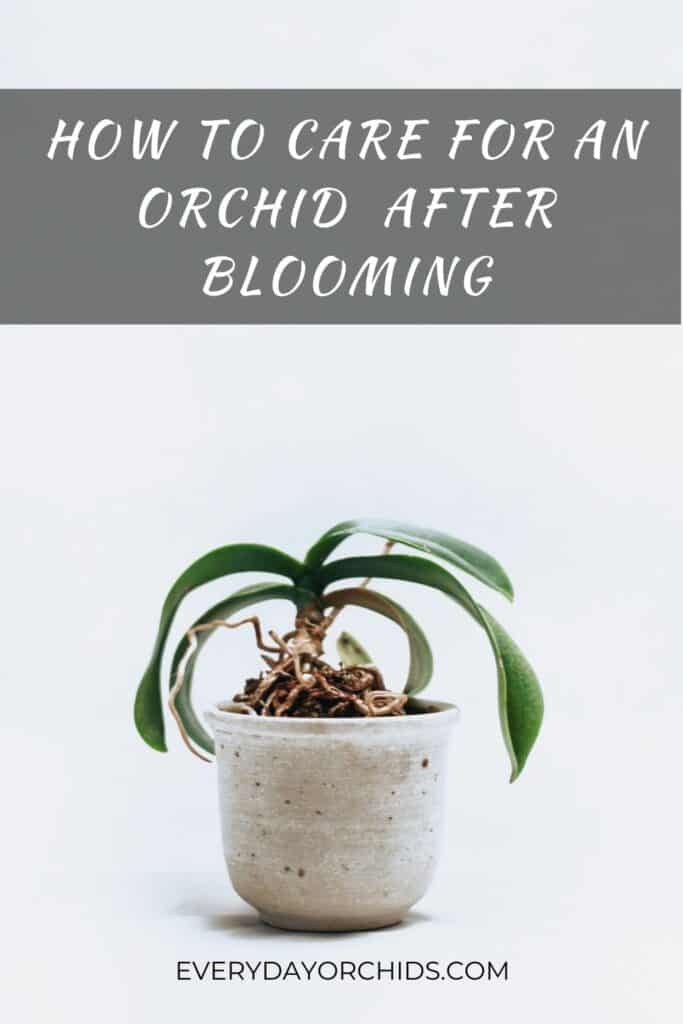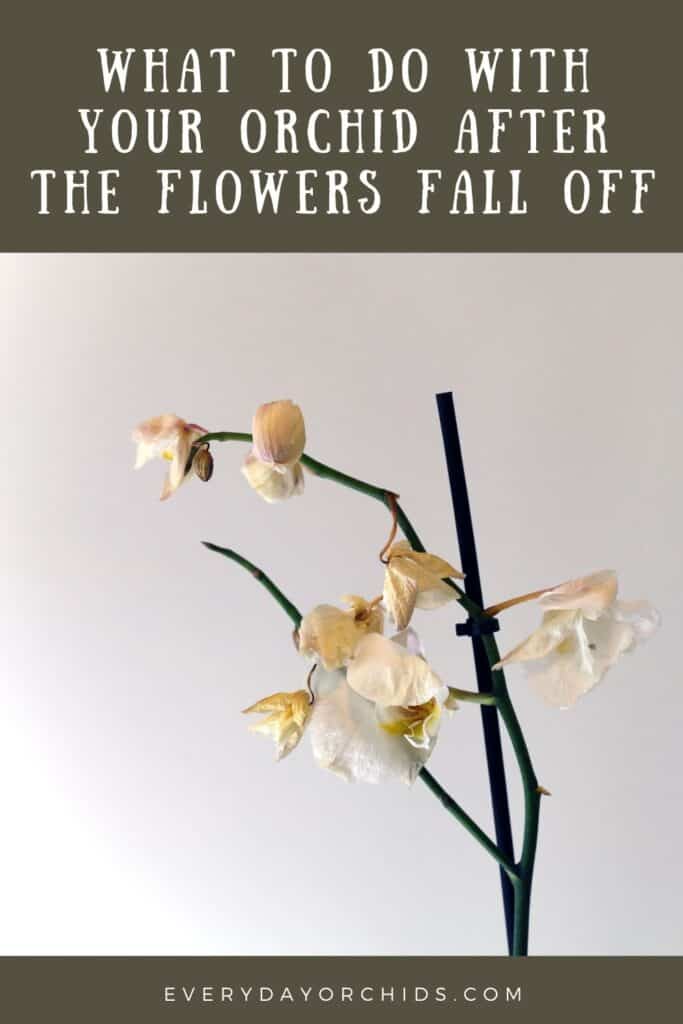Let’s talk about orchid care after flowering. As in, what do you do with an orchid after the flowers fall off? Do you throw it away? The answer is no, definitely do not throw your orchid away!
As long as the leaves are still green and healthy and the roots are in good shape, your orchid is still alive. It can even rebloom again the following year with the right care.
After an orchid loses its flowers, it is considered a “resting orchid.” The orchid will rest for a short time before it enters the growth phase, often during the late spring or summer. Orchid care after flowering involves some pruning during this resting period and temporarily decreasing watering and fertilization. This is also the best time to repot your orchid.

After an orchid loses its blooms, some people may lose interest in this lovely plant. I’ve seen people toss away their flower-less orchids or give them away on Facebook marketplace for free. Don’t make this mistake! Your orchid likely has many years of life ahead, provided you care for it well during this time.
In this article, I’ll go over orchid care after flowering in more detail. You’ll learn what to do after your orchid’s flowers fall off and how to care for your resting orchid. I’ll also give you some tips on how to get your orchid to rebloom. Keep reading to learn more.
Please note that these links are affiliate links and as an Amazon Associate, I earn from qualifying purchases. Purchases made through affiliate links in this post may generate commissions at no additional cost to you. Use this link for a discounted Amazon Prime trial. Thank you for your support!
Table of Contents
Understand An Orchid’s Different Cycles/Phases
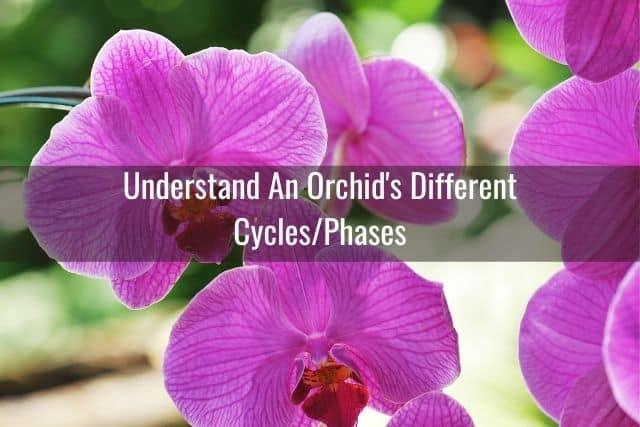
The top reason why you shouldn’t throw away your orchid after the flowers fall off is, it’s still alive!
Orchids are perennial plants and will rebloom year after year. An orchid doesn’t die after the flowers fall off. Instead, it transitions through various phases before it reenters the blooming phase again.
Resting Phase
After the blooming phase is done, the orchid enters a “resting period.” During the resting period, the orchid’s focus is on harvesting energy.
You may notice that the orchid doesn’t do much of anything during this time. It doesn’t grow any leaves or roots. All the flowers are gone and nothing is happening. The flower spike might be turning yellow or be completely brown. This is partly why some people may think that the orchid is dead.
The length of time for an orchid’s resting phase will vary, depending on the orchid species. Some orchids have such a short resting phase that it comes and goes without really being noticed. Other orchids have a longer resting phase.
The resting phase is a necessary break for the orchid after it has spent all that energy and effort in bloom production.
Growth Phase
After the resting phase, the orchid moves into the growth phase. During the growth phase, the orchid uses the harvested energy to grow new roots and leaves.
This often occurs during the warmer months, namely late spring and summer. The orchid needs more frequent watering and fertilization during this time.
Dormant Phase
After the growth phase is over, many orchids enter into dormancy during fall and/or winter. During dormancy, growth slows. This can also be considered as another resting period for your orchid, albeit a longer one.
You can water your orchids less frequently this time, and fertilize only once a month, if even that. Some orchids, such as the Dendrobium Nobile, may even need a winter rest, meaning no water or fertilizer for a period of time.
Blooming Phase
Throughout all of this, the orchid is also preparing for the next blooming cycle. An orchid can go anywhere from 8 to 9 months between blooming cycles.
For many orchids, their blooming phase occurs in the late winter months. The length of the blooming cycle varies between orchid varieties, with some orchid blooms lasting just a couple weeks like other orchid species can bloom for months on end.
Orchid Care After Flowering: What You Need To Do
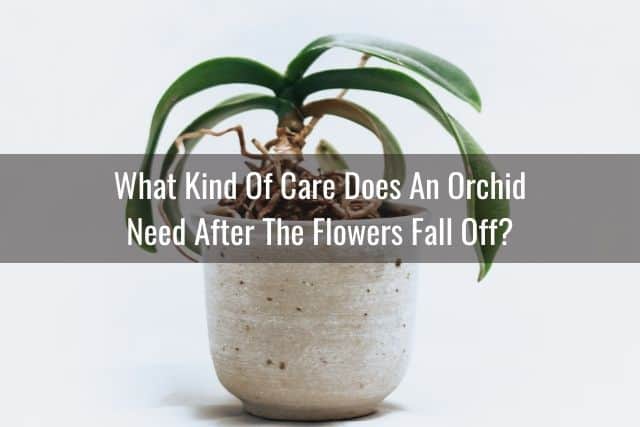
After an orchid is done blooming, its care requirements, in many ways, will be similar to what was needed during the blooming period. I’ll talk about the different care aspects below.
Orchid Care After Flowering: Lighting Requirements
Continue to give your orchid lots of bright, indirect light after the flowers fall off.
Many orchids need anywhere from 8 to 12 hours of bright, indirect sunlight each day. This is true even during the resting phase. Do not decrease light exposure during this time.
Light is essential for energy harvesting, root and leaf growth, and bloom production in orchids.
If your home doesn’t have good natural lighting, you may need to invest in artificial lighting for your orchid. You can use grow lights for your orchid to boost the amount of light it gets each day. As an added bonus, grow lights provide orchids with the full spectrum of light. This allows orchids to grow faster and produce more flower spikes.
Orchid Care After Flowering: Watering Needs
Do you need to water an orchid after the flowers fall off?
Yes, you will need to continue to water your orchid, but the amount and frequency of water will depend on the type of orchid.
In orchids with pseudobulbs, you will need to temporarily reduce watering frequency. This is to prevent overwatering. You can resume regular watering once you see new growth start to develop on your orchid.
If you have a monopodial orchid, such as a Phalaenopsis or Vanda orchid, there should be no change in how you water your orchid.
Depending on how these orchids are potted and what type of potting media you are using, they may need to be watered each week. Monopodial orchids lack storage organs for holding water, so don’t reduce your watering for these particular orchids during the rest period.
Orchid Care After Flowering: Humidity And Fertilization Needs
In addition, maintain humidity levels to meet your specific orchid’s requirements. Prevent fungus and mold growth by making sure you have good air circulation around your orchid pots.
If you aren’t sure what the humidity levels are around your orchid’s growing area, use an inexpensive hygrometer to measure humidity levels. I use this hygrometer by ThermoPro and really like it. It tracks both humidity and temperature, gives me the day’s highs and lows, and lets me know at a glance if my orchid’s growing area is too dry or wet.
Temporarily decrease fertilization during the resting period. Once you start to see new leaves and root buds emerge, that is your cue that the orchid is entering it’s growth phase.
Once an orchid is in its growth phase, you can resume fertilizing your orchid “weakly, weekly,” or every other week. In cooler months, as the orchid transitions into dormancy, decrease fertilization down to just once a month.
For more information, check out these guides on why orchids need humidity and how to fertilize your orchid.
Orchid Care After Flowering: Repot Your Orchid
The period after the orchid is done blooming is the best time to repot your orchid.
You can repot either during the resting phase or the growth phase. I would say either phase is fine because in some orchid varieties, the resting phase is so short you might miss it.
Most orchid varieties will need to be repotted every 1 to 2 years.
If you aren’t sure whether or not your orchid needs to be repotted, I would recommend first looking at the quality of the orchid potting media. Most orchid potting media made of bark chips will start to degrade and decompose after about 18 months, sometimes sooner if the orchid was watered frequently.
As the bark chips naturally break down into smaller pieces, this decreases the amount of airflow between orchid roots. If your orchid is potted in this type of potting media, I would recommend repotting now if you didn’t do so the year prior.
If your orchid is potted in sphagnum moss, and you are new to orchids, knowing how and when to water your orchid in moss can be tricky. Improperly watering an orchid in moss can lead to root rot and orchid death.
In this case, I would recommend repotting your orchid into more traditional orchid potting media after the flowers fall off. This would be the potting media made of bark chips, perlite, charcoal and other fast-draining components.
Unsure of what type of potting media to use? Here are some handy guides to help you decide:
- How to choose the right potting media for your orchid.
- The pros and cons of using bark vs. moss for orchids.
- You can also learn about alternative orchid potting media and methods here.
- All about traditional orchid bark potting media components. This is a great read if you are looking to make your own custom potting mix.
Lastly, if you have an orchid with lots of air roots, learn how to repot an orchid with air roots here.
Orchid Care After Flowering: Prune Your Orchid
I usually like to combine repotting with pruning. Repotting is the best time to do some general upkeep of your orchids.
After the flowers fall off your orchid, prune away any dead or dying flower spikes. In addition, trim off rotted roots or dead leaves.
I’ll go over where to cut the flower spike in more detail below.
Where Do You Cut An Orchid After The Flowers Fall Off?
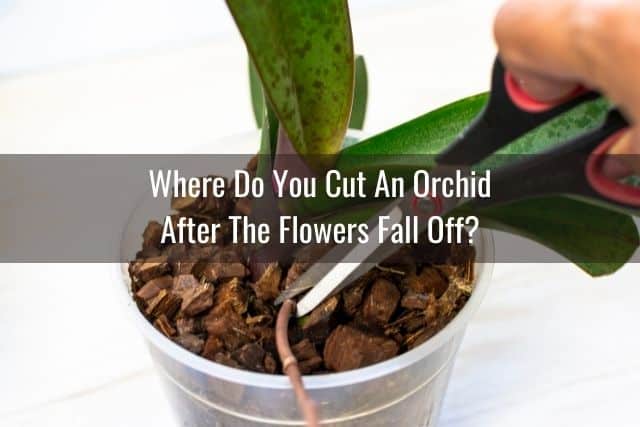
After an orchid loses its blooms, you will have some opportunities for pruning your orchid.
If the flower spike is looking dry, yellow or brown or withered, prepare some sterilized gardening shears.
Depending on how far down the spike the yellow or brown discoloration extends, you can cut the flower spike 1-inch below the discoloration, or cut the flower spike off at the base.
In my experience, if a flower spike is starting to turn yellow or brown, it is spent and will no longer produce blooms. This is completely natural and to be expected.
The yellow or brown color indicates that the flower spike is dying and the blooming season is coming to an end. It does not mean that your orchid is dying. Only the flower spike is.
In most cases, if left unchecked, that discoloration will continue to spread down the base of the flower spike as it dies. You can safely cut off a yellow or brown flower spike at the base.
Afterwards, seal the cut end with some ground cinnamon powder if you prefer. Sterilize your pruning shears before storing them away.
Pruning off the dying flower spike is actually beneficial for your orchid. It can redirect its energy into getting stronger and growing more leaves or roots instead. Removing dying or dead flower spikes can also help trigger reblooming in your orchid.
However, if your orchid’s flower spike is still green and looks healthy, leave it on the orchid.
A green flower spike is still alive. In Phalaenopsis orchids, it has the potential to produce more flowers. The blooms will be smaller, but getting your orchid to rebloom from this green spike is possible.
How Do You Get An Orchid To Rebloom?
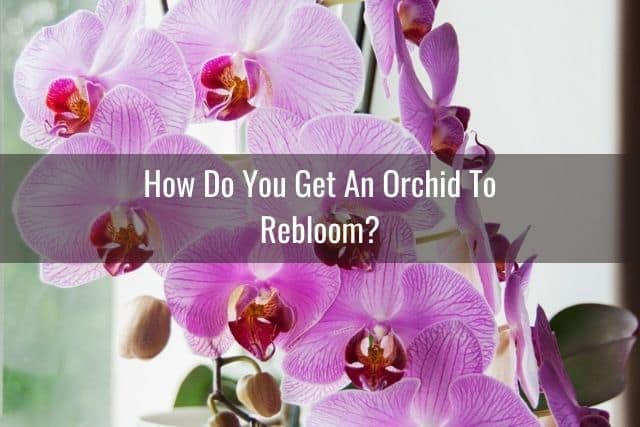
You can use a few simple techniques to get your orchid to rebloom.
Note: Phalaenopsis orchids are pretty much the only orchids that can rebloom again soon after a blooming cycle has finished. Think of this as a “second” or “bonus” blooming cycle, or “extending the blooming season.” Be aware that reblooming is not guaranteed. Some Phalaenopsis species will not rebloom from the same spike no matter what you do.
If you have a Phalaenopsis orchid and the flower spike is still green, leave it on the orchid. Do this even if all the flowers have fallen off.
Take a sterile pair of gardening shears and find the area on the flower spike where the last flower fell off. Cut the spike in this area, cutting just above the first intact node.
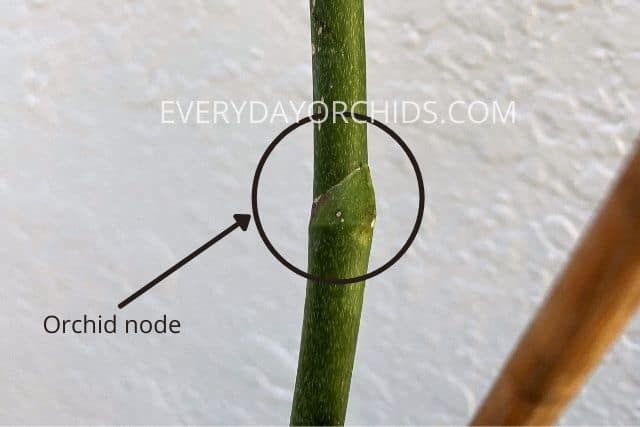
A node looks like a triangular bump or bulge along the length of the flower spike.
Trimming the flower spike above a node can encourage the orchid to grow a new flower spike from that node or a node further down. When a new flower spike grows from a lower node, it forms a branch off the main spike.
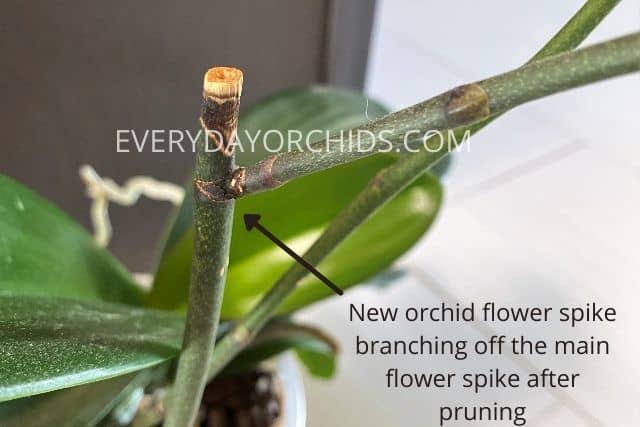
It can take your orchid anywhere from 8 to 12 weeks to rebloom. However, this is not always guaranteed, even if you do everything right. Don’t be discouraged if you can’t get your orchid to rebloom. I go over some of the reasons why this happens below.
If you are lucky, a new flower spike will start growing from a lower node on the existing spike. As mentioned before, the flowers produced during this “bonus” second blooming cycle will generally be smaller.
Reblooming Double-Stemmed Orchids
If your Phalaenopsis orchid has a double flower spike, it is otherwise known as a double-stemmed orchid. If those flower spikes are still green, you have two options.
One, you can leave both green spikes intact and do nothing. However, it is unlikely that your orchid will be able to rebloom from both flower spikes, so don’t expect your orchid to rebloom.
If you are hoping to rebloom your orchid, you have a second option. You can cut one green flower spike down to the base and cut the other green spike just above a node. When you do this, choose the best-looking, healthiest flower spike to leave intact.
By pruning off one flower spike completely, you are signalling your orchid to focus its energy into the remaining flower spike and produce more flowers.
What If Your Orchid Doesn’t Rebloom?
There can be a number of reasons why your orchid doesn’t rebloom. It could be genetics. Some Phalaenopsis orchid species simply can’t rebloom from an exisiting spike. It’s not you, it’s the orchid.
Younger orchids or sick and weakened orchids will generally not be able to rebloom from an existing flower spike. This is partly because they lack the stored up nutrients and energy needed to generate a new flower spike so soon after a blooming cycle.
Other reasons why an orchid doesn’t rebloom include inadequate lighting or watering. It could also be that the orchid needs more consistent temperature drops at night. Another reason is that the orchid needs a bloom booster fertilizer with a higher phosphorus concentration.
There are many reasons why an orchid may not rebloom, and some of these factors may be out of your control. Don’t be discouraged if you can’t get your orchid to rebloom and extend its blooming season.
Do Orchids Grow Back After The Flowers Fall Off?
Yes, orchids do continue their growth after the flowers fall off.
As I mentioned above, the growth phase follows the orchid’s resting phase. During this phase, the orchid is primarily focused on leaf and root growth. A new flower spike will grow the following year during the next blooming cycle.
However, if you are wondering about the flower spike, the answer is no, the flower spike will not grow back after the flowers fall off and the orchid is done blooming.
Many flower spikes will turn yellow or brown at the end of the blooming cycle. When this happens, your orchid is telling you that particular flower spike is done and you can prune it off. It will not grow back.
Final Thoughts
After an orchid loses its blooms, it is not dead. It is merely entering a resting phase before it goes into a growth phase. During this time, you will need to provide specific orchid care after flowering is done.
Look over your orchid and prune off any dead flower spikes, leaves or roots. Decrease watering and fertilization while your orchid is resting, then resume regular watering and fertilization practices when you start to see growth appear. This is also a good time to repot your orchid.
If your Phalaenopsis orchid still has a green flower spike, you can try to rebloom your orchid. Using sterilized gardening shears, cut your flower spike above the first intact node. Cut off any other existing flower spikes down to the base. Water and fertilize your orchid as usual, and make sure it has plenty of bright, indirect light.
If you are lucky, you will see another flower spike start to grow within the next couple of months. If your orchid doesn’t rebloom, don’t get discouraged. It will likely rebloom next year during its normal blooming cycle, provided you continue to meet its care needs.
Long story short, don’t make the mistake of tossing away your orchid after the blooms fall off. The end of a blooming cycle is merely one phase of an orchid’s life. With the right care, your orchid can rebloom each year and live for many years in your home.
If you enjoyed this article, please pin it and share!
